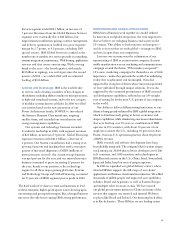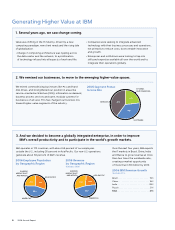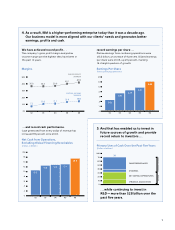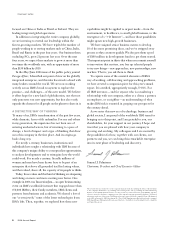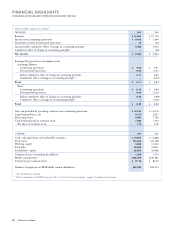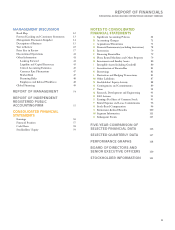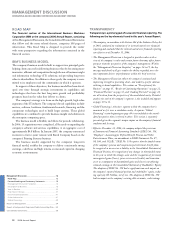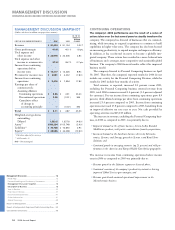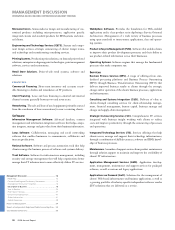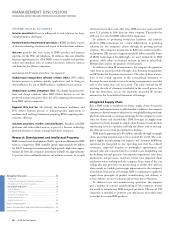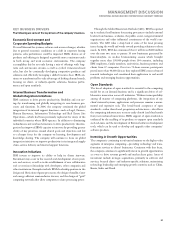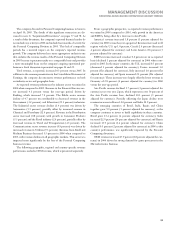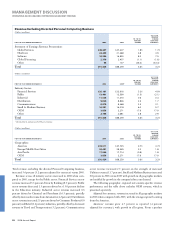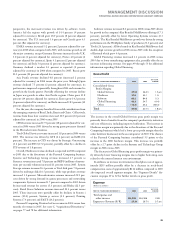IBM 2006 Annual Report Download - page 17
Download and view the complete annual report
Please find page 17 of the 2006 IBM annual report below. You can navigate through the pages in the report by either clicking on the pages listed below, or by using the keyword search tool below to find specific information within the annual report. The consolidated gross profit margin increased 1.8 points to 41.9
percent versus 2005. An improvement in the Hardware margin (1.9
points) contributed 0.6 points to the overall margin improvement.
This increase was driven by the sale and resulting absence of the
lower margin Personal Computing business. In addition, the Global
Services margin improved 1.5 points versus 2005 to 27.5 percent.
This increase was driven by several factors: the restructuring actions
taken in the second quarter of 2005 to improve cost competitiveness,
improved utilization levels and ongoing productivity initiatives. The
Software margin increased slightly. The Global Financing margin
declined 4.4 points versus 2005 to 50.3 percent primarily driven by
higher borrowing costs. This decline had an immaterial impact on
the company’s overall margin due to the size of the segment.
Total expense and other income increased 2.8 percent in 2006
versus 2005. The increase was primarily due to the company’s invest-
ments in acquisitions and investments the company is making in its
software and services businesses and emerging markets.
The provision for income taxes resulted in an effective tax rate of
29.3 percent for 2006, compared with the 2005 effective tax rate of
34.6 percent. The 5.3 point decrease in the 2006 effective tax rate
was primarily attributable to the net effect of several items. In 2006,
the tax rate was favorably impacted by the absence of the foreign
earnings repatriation-related tax charge recorded in the third quarter
of 2005 (4.3 points) as well as a benefit from the fourth-quarter 2006
settlement of the U.S. federal income tax audit for the years 2001
through 2003 ( 3.0 points). These benefits were partially offset by a
one-time tax cost associated with the 2006 intercompany transfer of
certain intellectual property (4.3 points). The remaining items were
individually insignificant.
Total Assets declined approximately $2.5 billion ($6.2 billion
adjusted for currency) primarily due to lower prepaid pension assets
($10.0 billion) and a decrease in Cash and cash equivalents ($4.5 bil-
lion). These decreases were partially offset by increases in Goodwill
($3.4 billion), long-term deferred tax assets ($2.0 billion), Marketable
securities ($1.9 billion), trade receivables ($1.2 billion), financing
receivables ($1.8 billion) and Intangible assets ($0.5 billion).
The increase in Total Liabilities of $2.1 billion (down $0.4 billion
adjusted for currency) was primarily driven by Compensation and
benefits ($1.3 billion), Deferred income ($1.3 billion) and Accounts
payable ($0.6 billion). These increases were partially offset by
decreases in long-term deferred tax liabilities ($1.0 billion) and
restructuring liabilities ($0.4 billion). Total debt of $22.7 billion was
essentially flat versus 2005.
The decrease in Stockholders’ Equity was primarily driven by
retirement-related charges ($7.6 billion) and net common stock trans-
actions ($5.4 billion), partially offset by increased Retained earnings
($7.7 billion). The retirement-related driven decrease in Stockholders’
Equity and the decrease in prepaid pension assets were as a result of
the company’s adoption of SFAS No. 158. See note V, “Retirement-
Related Benefits,” on pages 100 to 111 for additional information.
Global Services signings were $49 billion in 2006 as compared to
$47 billion in 2005. The Global Services backlog is estimated to be
$116 billion at December 31, 2006, versus $111 billion at December
31, 2005.
For additional information, see the “Year in Review” section on
pages 22 through 36.
Looking forward, the company’s long-term financial model objec-
tive is to generate 10 to 12 percent earnings per share growth over the
long term through a combination of revenue growth, productivity-
driven margin improvement and effective capital deployment for
acquisitions and returns to shareholders through dividends and com-
mon stock repurchases. The company’s ability to meet these objectives
depends on a number of factors, including those outlined on page 21
and on pages 89 to 92.
DESCRIPTION OF BUSINESS
Please refer to IBM’s Annual Report on Form 10-K filed on February 27,
2007, with the SEC for a more detailed version of this Description of Business,
especially Item 1A. entitled “Risk Factors.”
IBM is a globally integrated innovation company, serving the
needs of enterprises and institutions worldwide. The company
seeks to be a partner in its clients’ success by enabling their own
capacity to innovate, so that they may differentiate themselves for
competitive advantage in a globalized economy. IBM views enterprise
innovation not only in terms of products and services, but across all
dimensions of a business: its business processes, business model, man-
agement systems, culture and role in society. To help clients achieve
growth, effectiveness, efficiency and the realization of greater value
through innovation, IBM draws upon the world’s leading systems,
software and services capabilities.
MANAGEMENT DISCUSSION
INTERNATIONAL BUSINESS MACHIN ES CORPORATION AND SUBSI DIARY COMPANIES
15
Black
MAC
2718 CG10


